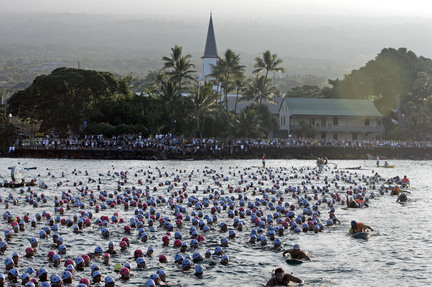Oct. 7 (Bloomberg) — Dede Griesbauer said she might have
bypassed her eight-year career as a Wall Street trader if
Stanford University offered a taste of her current profession —
triathlon.
The sport wasn’t available at Stanford when Griesebauer was
a student there 20 years ago. That might change as the National
Collegiate Athletic Association considers a proposal to start
the swim-cycle-run competition on the path to becoming an
accepted intercollegiate sport.
Adding women’s triathlon would create as many as 10 spots
for female athletes at each college that fields a team. The
addition would help schools meet Title IX standards requiring
women to be offered the same opportunities as men. It also could
have a far-reaching effect on the sport in the U.S., college
coaches, USA Triathlon officials and triathletes said.
“It brings focused, disciplined, mature young adults to
our campus who are goal-oriented, which helps in the classroom
and everywhere else,” Debbie Warren, athletic director for
Arlington, Virginia-based Marymount University, said in a
telephone interview.
Marymount is the only school currently offering triathlon
as a varsity sport. Warren said she decided to add it this year
at the Division III level, even though there is no championship
or other varsity programs. The school competes against so-called
club teams, which get no financial support from their
universities.
“How often does a school get a chance to be the grass-
roots leader of something that I think is going to be really
great,” she said. “This must be what they felt like when they
started basketball.”
Annual Budget
Warren said her annual budget for triathlon is about
$54,000, which covers uniforms, travel and race entry fees. The
school spends about $100,000 each on its baseball and lacrosse
teams.
The NCAA Legislative Committees for Divisions I, II and III
will vote at its annual convention in Indianapolis in January on
a proposal to make triathlon a so-called emerging sport, a
designation only given to women’s athletic programs.
An emerging sport gains full varsity status if 40 schools
add it within 10 years. Other current women’s sports that have
followed that route to varsity status include ice hockey, water
polo and rowing.
“There’s a lot of interest out there in triathlon,”
Marilyn Moniz-Kaho‘ohanohano, chairwoman of the NCAA Committee
on Women’s Athletics, said in a telephone interview. “Wherever
there’s opportunities for women to go to college and get
scholarships and have that dream met, we’re all for it. That’s
why we’re here.”
Stanford, along with Arizona, the U.S. Air Force Academy,
Denver, Drake, Monmouth, North Carolina-Asheville and Northern
Iowa have submitted letters to the NCAA in support of adding
Division I women’s triathlon teams. Adams State and Colorado at
Colorado Springs are seeking Division II teams, while Maine-
Farmington has joined Marymount with support for a Division III
team.
Men’s triathlon isn’t part of the proposal. If the sport is
added for women, men’s programs will likely follow, Warren of
Marymount said.
About 150 schools have club programs in triathlon and about
400 women competed in the 2013 collegiate national championship
in Tempe, Arizona. The event, staged by USA Triathlon, isn’t an
official NCAA championship.
Wall Street
Griesbauer, a 42-year-old Short Hills, New Jersey, native,
stuck to swimming at Stanford and earned a Master’s degree from
the University of Pennsylvania’s Wharton School of Business. She
worked most recently on Wall Street for Boston-based MFS
Investment Management, before returning to the sport and joining
the professional ranks in 2005. She has won two Ironman
triathlons and was the top U.S. woman finisher in the Ironman
World Championship in Hawaii in 2007 and 2009.
She said she wonders what her athletic career might have
been like if she had competed in triathlon in college.
“One of the greatest things in my life was the four years
I spent at Stanford as a student athlete,” said the 10-time
All-American swimmer and captain of the Cardinal’s 1992 national
championship team. “In the U.S., as good as our swimmers are,
and as good as our runners are, we lag at triathlon. Making it a
collegiate sport will help progress the U.S. in terms of being
more competitive on the world stage.”

